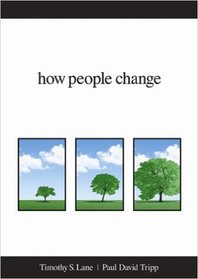
How People Change by Timothy S. Lane and Paul David Trip, New Growth Press, 2006, available in multiple formats.
Another one of those books that’s been sitting on our shelves for years. At some point Jim was in a group that studied it, and he felt that the discussions were very worthwhile. So when I was casting around for a good Christian book to read in my early-morning study time I settled on this one. We had had some excellent teaching at our church lately about how God brings about fruit in our lives, and one of the big takeaways for me was that fruit, growth, and change all happen slowly and organically. Our senior pastor has said before, “You don’t make an apple tree productive by stapling fruit to the branches.” That’s such a funny illustration that it sticks in the mind. Can’t you just see the guy with the stapler and the bag of apples, reaching up to grab a twig and use his trusty Swingline?
To start with, just take a look at the cover. The tree grows organically, and, interestingly enough, it grows proportionally. You don’t have a great big trunk with just a few leaves. You don’t have a massive canopy of branches and a tiny trunk. And if one part of the tree is indeed out of proportion, there will come a time when that defect will become clear. (True story: When we lived in Virginia our house had a massive oak tree to the side. It was at least 75 feet tall and in an extremely dangerous position between our small house and our neighbor’s. One night there was a storm with fairly high wind, and as we came home after an outing we saw that all the lights on our block were out. And then we saw . . . that there was no tree beside our house. And then we saw . . . where the tree was. It had come down, striking our neighbor’s roof a glancing blow and then filling up his entire front yard. Considering what could have happened, we got off pretty lightly. No one’s house was destroyed. And you know what the problem was? The tree had only about a third of the normal root system for that size of a tree. When the gust of wind hit it just so, it didn’t have the anchor to keep it in place, and down it came. But the root system would have been fine for a much smaller tree.)
Authors Lane and Tripp are associated with the Christian Counseling and Educational Foundation (CCEF), a biblical counseling organization. Earlier in this blog I wrote about another helpful book that has come out of this group, When People Are Big and God Is Small by Ed Welch. Both of these books are solidly grounded in the Bible and then bring in many specific examples of real-life situations where people have applied (or failed to apply) what the Bible teaches. There are no stories of sudden change here. While the Christian New Testament teaches that salvation or conversion, when a person comes to the point of faith in Jesus Christ, happens at a specific point in time, that person’s growth as a Christian is a long process. I love what the Apostle Paul says in this regard:
I’m not saying that I have this all together, that I have it made. But I am well on my way, reaching out for Christ, who has so wondrously reached out for me. Friends, don’t get me wrong: By no means do I count myself an expert in all of this, but I’ve got my eye on the goal, where God is beckoning us onward—to Jesus. I’m off and running, and I’m not turning back. (Philippians 3:12-14 The Message)
This post is running rather long, so rather than my trying to list the ideas I highlighted as I read, let me conclude by describing a central image in the book: that of a thornbush and a fruit tree. How do you know which one you have? By its response to heat. What does it produce as the sun shines on it? (Another true story: When Gideon was little, say three or four years old, he spotted some little plants growing in our flowerbeds. I told him I thought they were weeds, but he said he liked them. Wanting to foster his interest in gardening–now alas pretty much totally extinguished–I helped him dig some of them up and plant them in an empty spot. We watered them and waited. The summer went on. They got bigger and bigger. Suddenly I looked at them and realized they looked just like . . . ragweeds. Those cute little plants had finally revealed their true nature.)
This isn’t the type of book that you gulp down all at once. It doesn’t have a narrative spine. Each chapter is full of ideas that need to be chewed over, meditated up, and applied. Not an easy task! The absolute opposite of escapist literature, I’d say.